#electron micrograph
Explore tagged Tumblr posts
Text

Crystal of virus. Magnification : 122, 700X. Electron micrograph. Courtesy Dr. C. Morgan, Department of Microbiology, Columbia University.
Module, proportion, symmetry, rhythm, by Kepes, Gyorgy, 1906-
61 notes
·
View notes
Text
At the molecular level, the chains of carbohydrates bind together through hydrogen bonding to form bundles (figure 22.14).

"Chemistry" 2e - Blackman, A., Bottle, S., Schmid, S., Mocerino, M., Wille, U.
#book quotes#chemistry#nonfiction#textbook#carbohydrates#hydrogen#chemical bonding#bundles#cellulose#microfibrils#cell wall#electron micrograph#beta#glucose
0 notes
Text
For example, let's look at electron micrographs of two very different crystals of calcium carbonate.



"Chemistry" 2e - Blackman, A., Bottle, S., Schmid, S., Mocerino, M., Wille, U.
0 notes
Text
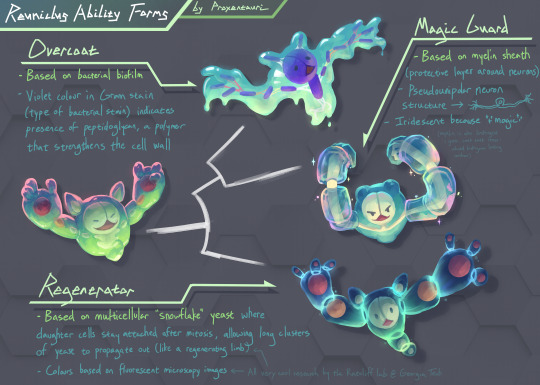
when i saw @n0rtist's ability forms i had to do reuniclus.....i hope it's not too late to be featured in the video! :0 we may have crossed from ability form into actual alternate form territory (see the original colours below the cut to see how crazy different they could have been)
as someone in evo microbio this was insane amounts of fun to do and i was able to pull inspo from places i'd never think to reference in my regular art!
itemized essay explaining the science and my design choices in more detail below the cut:
Ability Form 1: Overcoat
The science
Based on bacterial biofilm, which is basically when a bunch of bacteria get together in the same spot and start excreting this sticky slime stuff that structurally keeps the bacteria together (and also act as a medium for sharing useful resources between the bacteria, like enzymes, nutrients, etc.).
The design
The strings connecting the bacteria is based on what the slime stuff looks like on a microscopic level, specifically in electron micrographs like this one
The violet colour of the (rod) bacteria in the biofilm is a reference to Gram staining, which is a type of bacterial stain used to classify bacteria into two groups: bacteria that contain peptidoglycan in their cell walls (which stain violet) and bacteria that don't (these stain pink). Peptidoglycan is this pretty chonky polymer compound that's used to strengthen bacterial cell walls, so I thought it fit the role of Overcoat (which protects your Pokémon from things like weather)
Ability Form 2: Magic Guard
The science
Based on the myelin sheath, which are these segments of tube-like insulation that surrounds your neurons (see picture here). Mostly people talk about how it makes your neural signals propagate faster, which is true, but this ability form was more of a reference to its general protective role; it physically and electrically insulates your neurons. (Surprisingly I could not find a super good primary source for myelin providing physical protection, so don't cite me on that, but given it's literally a physical barrier this seems like a pretty safe assumption.)
The design
The entire body is based on a pseudounipolar neuron, which just means it only has one part extend out of the main body but shortly after it splits into two long parts (axons). I could have made it a bipolar neuron I guess (two parts extend out of the main body), but having a neck made it look a little closer to the base form's body
I wanted to give it dendrite fingers but it looked too creepy. I'm not sure if the three long fingers I gave it in the final design made it less creepy.
Since Overcoat and Magic Guard are both shield-type abilities, they're drawn as more closely related on the the phylogenetic tree (white thing in the center).
Ability Form 3: Regenerator
The science
This one is the most hype imo. In 2015 Dr. Will Ratcliff did this pretty sick experiment about the evolution of multicellularity (since at some point a long time ago life was single-celled) where he kept propagating the same single-celled yeast for a mega long time, and eventually the yeast evolves a multi-cellular "snowflake" form where after undergoing mitosis, the resulting daughter cells don't split, but stay attached, resulting in the yeast forming these clusters that create these cute little branches. I don't know where I was going with this. Oh right, the branching out reminded me a lot of regenerating limbs, so that was the inspiration for this one.
Anyway this is like one of my favourite experiments ever, there's some pretty good news articles out there about if you want to learn more about it!
The design
The segments are yeast cells, and the balls within are the nuclei.
The colour scheme was based on this fluorescent microscopy photo of the snowflake yeast. Originally I had the nuclei be bright orange in reference to this other microscopy picture but I thought the colour scheme was deviating too much from the base form for an ability form lol.
Speaking of here's the original unhinged colour drafts:
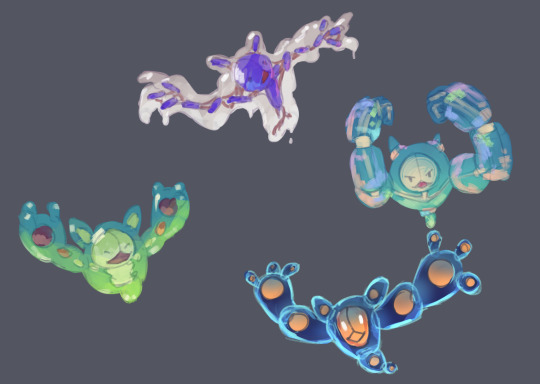
if i did commit to the full alternate form i think the biofilm one is poison, myelin one is fighting, yeast one is uhh...dude idek, i mean the fluorescent microscopy vibe is pretty strong so maybe electric lol? it's giving ghost vibe too though
i was originally planning on citing stuff but it's a tumblr post and I've already linked Ratcliff's work and i want to go to bed lol. If any of the science is wrong just call me out i'll fix it. otherwise, i hope someone out there appreciates the science references !! it's 8am good Night
#art tag#biology#evolutionary biology#microbiology#reuniclus#pokemon#ability forms#biology art#i guess#bacteria#evolution#nintendo#pokemon fanart#pokemon gen 5
380 notes
·
View notes
Text
The Real Life Biology of the Three Body Problem Series
In the first book of Liu Ci Xin's Three Body Problem series, we are introduced to our main antagonists, the Trisolarans. Whilst we never get to see them directly, we are shown some of their biology via the game that our protagonist plays.
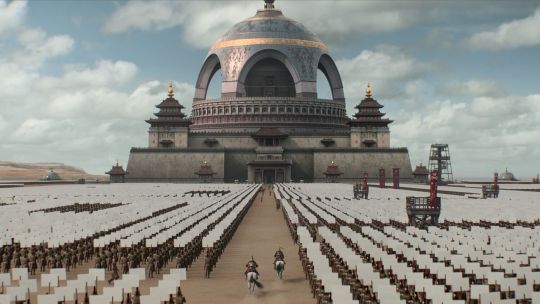
ID: A grand domed palace in a chinese style sits in the background of the image. The foreground has hundreds of ancient Chinese soldiers holding white placards on sticks. Two people dressed in Chinese armour can be seen riding horses towards the palace.
In the game it is revealed that Trisolaris, the planet in the Alpha Centauri system on which the aliens reside, revolves around not one, but three suns. As such, the system is subject to the classic physics conundrum of the three body problem (after which the first book in the series is named), which states that for most initial conditions the trajectories of three celestial bodies is chaotic and difficult to predict.
This means that Trisolaris experiences very extreme, unpredictable conditions, divided into "stable eras" and "chaotic eras". Stable eras come about when Trisolaris settles into orbit around one of its three suns, bringing relative prosperity to the planet. However, chaotic eras result in disasters, such as extreme droughts, seemingly endless nights, and even changes in gravity. The first novel partially revolves around the Trisolarans attempting to see if humans could collectively solve the three body problem and bring some level of predictability to their planet.
During the course of the game, it is revealed to the protagonist (and us, the readers), that in order to cope with the devastation and unpredictability of chaotic eras, the Trisolarans can dehydrate themselves and enter a spore-like state, hibernating until the next stable era comes. This allows them to bypass some of the extreme conditions and ensures the survival of the species as a whole.
Believe it or not, we have our very own Trisolarans here on Earth. In fact, there's loads of examples, from bacteria to triops, to my favourite of the bunch, Bdelloid Rotifers.
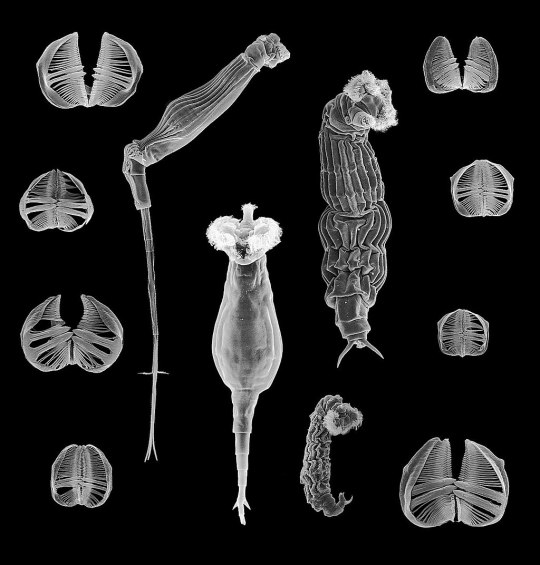
ID: An electron micrograph of some Bdelloid Rotifers and their mouthparts. They are long and slender, with a distinct mouth and tail section. Their mouthparts look like two semicircles lined with a comb-like structure.
These microscopic animals look freaky, because they are. If you've got any media literacy you've probably picked up by now that I am segueing here because they are somewhat similar to the aliens in the Three Body Problem, except this time they are very much real. Like the Trisolarans, Bdelloids live in very ephemeral environments: their usual haunts are the very thin film of water on moss and lichen. As you can imagine, these do not last all that long, and thus when they dry up, so do the Bdelloid Rotifers; in biology, we call this process anhydrobiosis.
"Ok, that's all well and good Ocean Sunfish Hater, but why do you like these guys more than the other anhydrobiotic creatures that roam our good, green Earth?" I hear you ask.
So you know how things that reproduce asexually don't have all that much genetic variation, and how sexual reproduction gives you an edge over asexual populations since you can keep that genetic variation fun and funky fresh, and how that has been the cornerstone for eukaryotic reproduction? Well. Well. Just like me, Bdelloid Rotifers have been completely celibate for 35-40 million years, with some people even bringing that number up to 100 million years, when they diverged from their sister clade. So how do these turbo-virgins not go extinct, racking up tonnes of deleterious mutations, not having any advantageous innovations, and eventually exploding into a genetic soup?
The secret lies in their ability to dehydrate. Not only is it a really handy dandy way to stay alive when your only source of water is gone, it literally rips apart their cells and genes! And why! Why the fuck does that help? It sounds like the opposite of helping!
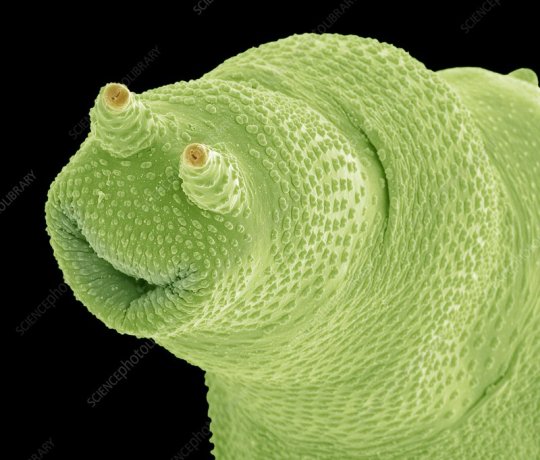
ID: An electron micrograph of the foot of a Bdelloid Rotifer. It has been shaded a light green. The structure looks almost like a face, with a smile and two stalk-like structures that could be mistaken for eyes. But this is not a face.
Having this mild-to-moderate level of cell membrane and chromosomal damage enables the Bdelloids to take up genetic material from their environment, mostly via their digestive systems, where their last meals are slowly being broken down to reveal that juicy DNA inside. When the water returns and the Bdelloids rehydrate, this genetic material gets incorporated into their chromosomes as their cells get back to work repairing themselves. And they sure ain't picky. In fact, it has been shown that in some species of Bdelloids, up to 8% of their genetic material has non-animal origins. How cool is that?
This is probably what has allowed them to continue adapting and evolving, even when they have been reproducing asexually for so long. This strategy has been so successful that the Bdelloids have managed to diversify into over 450 species. Pretty impressive for a class of animals that haven't had sex in over 40 million years.
Perhaps the Trisolarans might have a similar mechanism as part of their biology (even if they do reproduce sexually as stated in the book). Maybe they've managed to survive for this long because they have been able to absorb useful genes from their home planet, just like Bdelloids have been doing here on Earth. I don't know if these are what Liu Ci Xin had in mind when he wrote the Three Body Problem, but they sure were what I was thinking of when I read the book.
If you're still here, thanks for reading! I know this was a bit of a longer post, but I just wanted to use the new Netflix show to talk about one of my favourite books and one of the weirdest, most underappreciated animals.
#I would like trisolaris because the ocean sunfish would not survive there#bdelloid rotifers are so fucking cool and i think more people need to know about them#biology#ecology#Trisolaris#three body problem
102 notes
·
View notes
Text



Electron Micrographs
(Part 2 of 4)
Fugitive Glue, Lollipop, and Strawberry DNA
Fugitive Glue



I received a junk mail credit card offer, and I decided to take the piece of rubbery stuff that held the fake card to the paper to look at under the microscope. I originally referred to it as rubber cement, but I think it's actually called fugitive glue, among other names. Even exposed to air for a few days, it was still rubbery and malleable.
Unfortunately, being an organic compound, it did start to melt from the current of electricity that the microscope runs through it, which you can see happening in these images.
Lollipop Fragment




We had a bunch of leftover lollipops from Halloween at my house, so I took one of the flavors my brother didn't like to smash up and look at under the microscope.
In the first image, don't get confused by the background. The big angular piece is the lollipop, and the round things in the back are from the special tape used for keeping things on the stage (probably some bubbles trapped under it). I forget what kind of tape he said it was, but it was something able to conduct electricity.
The images of the sugar crystals are unclear and blurry because they, too, were actively melting while we were looking at them. Organic compounds just tend to do that. That said, you can still see the shapes of some of the crystals that hadn't yet melted.
Strawberry DNA



Having extracted some of my own DNA before, which I keep in an Eppendorf tube on my desk, I thought maybe it would be interesting to look at under the microscope.
However, I didn't want to potentially ruin the sample I had, so I followed NileRed's video to refresh myself on the process and used strawberries like he did. I also did it at 1/4 scale of what he did, because I really didn't need as much as he got. (By the way, DNA feels disgusting to touch. So much so that I used tweezers and forceps to handle it instead.)
Unfortunately, as you can see, the images aren't super clear or detailed, possibly for a few reasons.
The sample may still have had some moisture in it, which does interfere with how the machine sees it, I think.
It was also very clumped, because when you extract DNA, it all clumps together and I couldn't really separate the piece I was using into a thin layer.
It also may just be the size of DNA in general, which is molecular (just a very long one). I was hoping we'd see at least something, but I guess the indications of lines is all we could get.
I'm keeping the rest of the DNA we didn't use in some more Eppendorf tubes on my desk, because why not.
In the BDS Full images, the white parts are the hotter parts, where more electrons are being conducted through.
The scale in the bottom left corner of the images is in micrometers. 1 millimeter = 1000 micrometers
#microbes in hats#microbe posting#non-microbe post#electron microscopy#scanning electron microscopy#long post
20 notes
·
View notes
Text
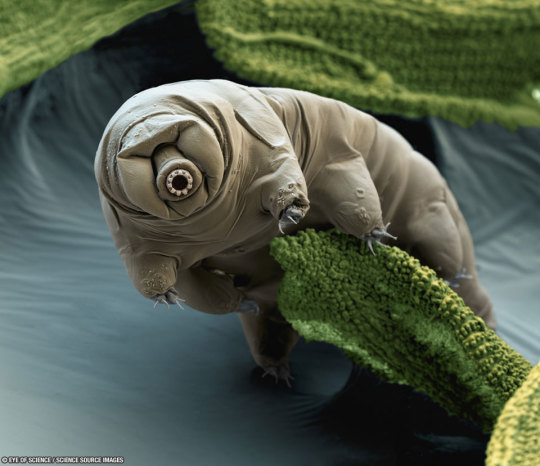
Is this an alien? Probably not, but of all the animals on Earth, the tardigrade might be the best candidate. That's because tardigrades are known to be able to go for decades without food or water, to survive temperatures from near absolute zero to well above the boiling point of water, to survive pressures from near zero to well above that on ocean floors, and to survive direct exposure to dangerous radiations.
The far-ranging survivability of these extremophiles was tested in 2011 outside an orbiting space shuttle. Tardigrades are so durable partly because they can repair their own DNA and reduce their body water content to a few percent. Some of these miniature water-bears almost became extraterrestrials in 2011 when they were launched toward to the Martian moon Phobos, and again in 2021 when they were launched toward Earth's own moon, but the former launch failed, and the latter landing crashed.
Tardigrades are more common than humans across most of the Earth. Pictured here in a color-enhanced electron micrograph, a millimeter-long tardigrade crawls on moss.
📷: Nicole Ottawa & Oliver Meckes / Eye of Science / Science Source Images
#science#tardigrades#biology#marine biology#animals#ScienceAcumen#astronomy#news#astronomy news#universo#space science#space exploration#space#research#outer space
245 notes
·
View notes
Text
Lily Orchard recently started using the term tardigrade as an insult because she would really like to call her detractors a different word and tardigrade sort of sounds similar, I guess. This has inspired me put together a little educational aid:

And just in case you need a little more help spotting the difference, here's a higher res image:

The original tardigrade scanning electron micrograph is from Steve Gschmeissner/Science Photo Library
#lily orchard#lily orchard critical#lily posting#Lily's not cool enough to be a tardigrade#stockholm#retardigrade
36 notes
·
View notes
Photo

2023 May 21
Tardigrade in Moss Image Credit & Copyright: Nicole Ottawa & Oliver Meckes / Eye of Science / Science Source Images
Explanation: Is this an alien? Probably not, but of all the animals on Earth, the tardigrade might be the best candidate. That's because tardigrades are known to be able to go for decades without food or water, to survive temperatures from near absolute zero to well above the boiling point of water, to survive pressures from near zero to well above that on ocean floors, and to survive direct exposure to dangerous radiations. The far-ranging survivability of these extremophiles was tested in 2011 outside an orbiting space shuttle. Tardigrades are so durable partly because they can repair their own DNA and reduce their body water content to a few percent. Some of these miniature water-bears almost became extraterrestrials in 2011 when they were launched toward to the Martian moon Phobos, and again in 2021 when they were launched toward Earth's own moon, but the former launch failed, and the latter landing crashed. Tardigrades are more common than humans across most of the Earth. Pictured here in a color-enhanced electron micrograph, a millimeter-long tardigrade crawls on moss.
∞ Source: apod.nasa.gov/apod/ap230521.html
165 notes
·
View notes
Text
2023 Reading Log pt 7
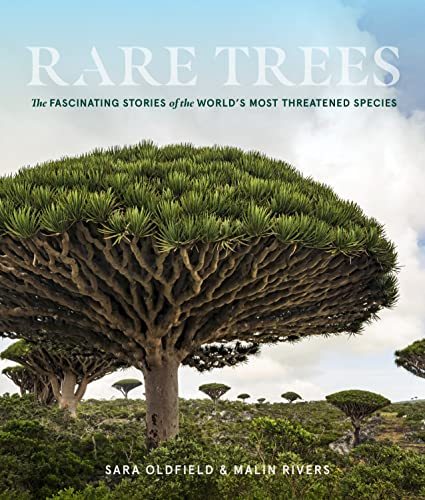
31. Rare Trees by Sara Oldfield and Malin Rivers. OK, so apparently that whole “less books about plants” pledge didn’t take. In my defense, this book is really pretty. It’s also very good; it’s about efforts for tree conservation around the world, and is published both as a public report and a fundraiser for the Global Trees Campaign. If you want to know what boots on the ground conservation work is like, its successes and its challenges, this is an excellent resource. And, like I said, the photographs are very pretty. The first chapter is about the overall history of forest conservation, and then future chapters discuss trees categorized by uses and by phylogeny. Honestly, I kind of wish they had picked one or the other of those organization schemes instead of splitting the difference, but that’s a quibble.
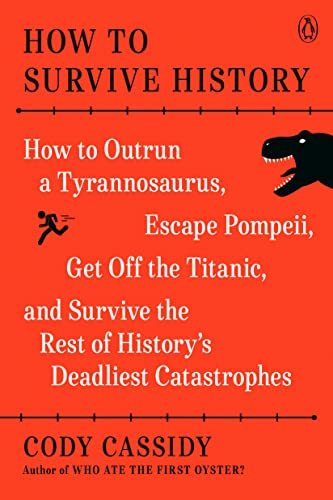
32. How To Survive History by Cody Cassidy. I’ve recommended some of Cassidy’s other books before (Who Ate the First Oyster? and …And Then You’re Dead), so I’m happy to report that this is his best yet. The theme is, what does science and the historical record tell us about how you could survive various catastrophes, or just hostile environments? I knew I was going to like it from the first chapter, How to Outrun a T. rex, which treats dinosaurs as just animals rather than kill crazy monsters. It also does an excellent job of summarizing Very Bad Times like the Donner Party expedition and the Magellan circumnavigation, and I learned a lot (like about how Magellan’s slave Enrique was the first person to actually circle the globe, having been captured by slavers in the Philippines and then being brought back around… and getting his revenge when he wasn’t freed as Magellan’s will proclaimed).
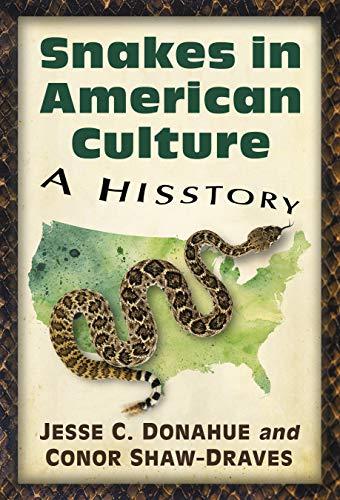
33. Snakes in American Culture: A Hisstory by Jesse C. Donahue and Conor Shaw-Draves. I didn’t expect this to be a searing indictment of the American medical profession of the early 20th century when I started the book, so that was a pleasant surprise. The first half or so is the story of how (white, upper class, male) “experts” denied that venomous snakes in the USA were really all that dangerous, while people (mostly poor, ethnic minorities and children) were dying in large numbers. Antivenin was only developed in this country as a side effect of the United Fruit Company’s desire to keep laborers from dying in the fields from snakebite, and the development of said antivenin was mostly done by volunteer labor and then marked up for tremendous profit by pharmaceutical companies! The back half, unfortunately, isn’t nearly as good, although it doesn’t go full conversion with its fairly sympathetic portrayal of snake handlers (which is something I’ve run into before). My biggest complaint is that this was written by humanities professors, and they needed a trained biologist to go over their draft. For example, they can’t format scientific names correctly, and don’t know enough about the history of science to understand that “virus” and “venom” were used interchangeably by some authors in the 19th century.
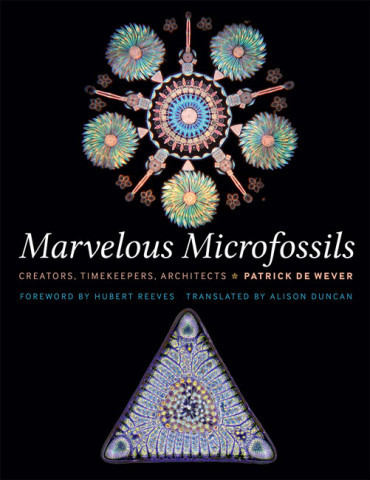
34. Marvelous Microfossils by Patrick De Wever, translated by Alison Duncan. Worst book I’ve finished this year? I think so. This book was originally written in French, but I can’t blame its problems on translation issues. It’s about plankton and other microfossils, what they can tell us about geology and how they’ve influenced art and culture. To start with the good, the book is gorgeous; each page is well organized, and it has lots of electron micrographs, photos and engravings by Ernst Haeckel. And that’s the first problem. The author seems to be a modern devotee of Haeckel’s science and philosophy, when both were full of garbage (Haeckel is the “ontogeny recapitulated phylogeny” guy, and one of the codifiers of scientific racism). His use of terminology is stuck firmly in the 19th century, and he doesn’t seem to care about modern cladistic phylogeny at all. And he has lengthy quotes from architects and philosophers instead of, you know, modern scientists, including lines specifically about how “we understand all there is to know” about plankton from like 1910. So I get huge “reject modernity, embrace tradition” vibes from this author, and that makes my skin crawl.

35. Nicole Angemi’s Anatomy Book by Nicole Angemi. Another “searing indictment of the American medical system”, only this one is more modern. The book is a loosely A-Z collection of pathologies, with case histories and photos. So this one is super gross, just a head’s up. Why I say it’s a searing indictment is that about 1/3 of the case studies talk about how the patient was ignored by their doctors initially, and had to spend time seeking second opinions taking them seriously, and how a number of things that could have been fixed more easily turned into huge, life altering (or ending) problems. The book is written by a pathologist’s assistant, and the introduction/biography would make a good “see, you can follow your dreams and get a career that you love later in life” inspirational story. I’m keeping a copy of this for my classroom, because I have plenty of students who are interested in medicine but not necessarily medical school, and because teenagers love gross pictures. Seriously, some of the descriptions of cysts and tumors made even my stomach turn.
#reading log#anatomy#medical history#snakes#herpetology#paleontology#plankton#botany#ecology#conservation#trees#world history
75 notes
·
View notes
Text

Eduard Gübelin. Scanning electron micrographs of opals, 17150x, ca. 1975.
220 notes
·
View notes
Text
The crystals shown in figure 8.27 were grown by a sea urchin that manipulated the crystallisation thermodynamics at every stage (see figure 8.27).

"Chemistry" 2e - Blackman, A., Bottle, S., Schmid, S., Mocerino, M., Wille, U.
#book quotes#chemistry#nonfiction#textbook#crystals#electron micrograph#microscopy#sea urchin#thermodynamics
0 notes
Text

A recent study in Nature Communications suggests that by 24 months, signs of heightened immune activity in most long-COVID patients will have returned to normal levels. Pictured above is a composite colored scanning electron micrograph of immune cells—including a single macrophage, two dendritic cells, and numerous white blood cells—involved in a cytokine storm, a life-threatening immune disorder. Cytokines are important for normal immune response, but when too many are released simultaneously it can be harmful.
COMPOSITE MICROGRAPH BY STEVE GSCHMEISSNER, SCIENCE PHOTO LIBRARY
#steve gschmeissner#photographer#national geographic#composite micrograph#science photo library#nature communications#long-covi#immune cells#cytokine storm#immune disorder#health#nature
13 notes
·
View notes
Text

'a scanning electron micrograph of the glochidium of an endangered pearl mussel [dwarf wedgemussel, alasmidonta heterodon] reveals "jaws" with which it will attach to its fish host' in pearls: a natural history - american museum of natural history + the field museum (2001)
68 notes
·
View notes
Text

Bacterial vaginosis (BV) affects nearly a third of all women in the U.S., and for over half of them, it's a recurring infection. BV has long been treated as a women's health issue—an imbalance of the vaginal microbiome. However, a groundbreaking new study suggests it's actually an STI and that treating male partners could dramatically cut recurrence rates.
Learn more about bacterial vaginosis and what experts say about new approaches to treatment: https://on.natgeo.com/43uYsFK
Pictured below, a scanning electron micrograph shows Lactobacillus bacteria, the beneficial microbes that help ward off harmful bacteria.
2 notes
·
View notes
Text

GODFLESH "Selfless" cover source
False-colour scanning electron micrograph (SEM) of human nerve cells growing on the surface of an integrated circuit (silicon chip). The picture was taken in 1985 in the course of research into biohybrid circuits, & demonstrates how much smaller organic circuits are than man-made ones. Biohybrid circuits are possible electronic devices of the future that would combine organic & inorganic components.
The neurons grow on a Motorola 16000 chip, which was in use on the first Apples (pre-Macintosh) in early 80s, and e.g. on Meade telescopes up until late 90s.
I can't credit the researcher / institute on this, but there's more photographs from the same set here — I figure the band must've been flicking through the same pics back then, and any of these could've as well ended up the cover of Selfless in an alternate timeline: https://www.sciencephoto.com/contributor/syp/
— Luke
33 notes
·
View notes